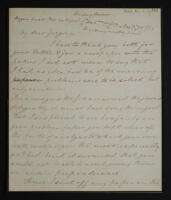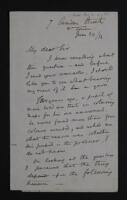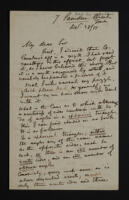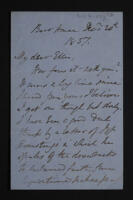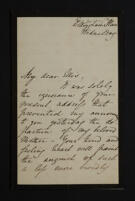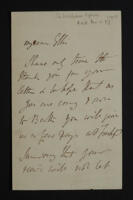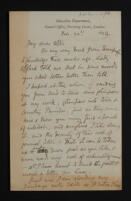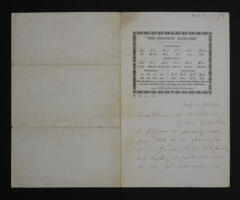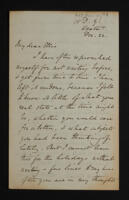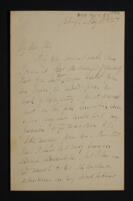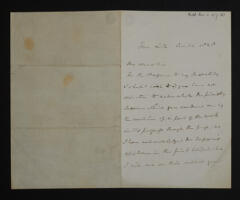58 letters addressed to "My dear sister".
Newton, Ann (c 1801-1879) sister of William WhewellThe fifth of five boxes containing letters from William Whewell to his family (Add.MS.c.191-193), arranged roughly chronologically.
Newton, Ann (c 1801-1879) sister of William WhewellThe first two of five boxes containing letters from William Whewell to his family, Add.MS.c.191-193, arranged roughly chronologically.
Newton, Ann (c 1801-1879) sister of William Whewell36 fragments, eight of them carrying notes as to which volumes they had been removed from. The group include two English fragments of the versified life of St Catherine (items 1-2), a 13th century fragment from the end of the Joseph story of the Poème Anglo-Normand sur l'Ancien Testament, removed from shelfmark K.3.77 (item 3), two fragments from the Avignon Selichot (items 7-8), two fragments from a medical text in Latin (items 9-10), a fragment on civil and canon law (item 17), and a fragment removed from Dr Hooke's papers carrying the header "Regulae Cromocritica de [Urina?]" inscribed by W. Derham as "Turkish writings & other Rhapsodical Receipts" (item 23).
The third and fourth boxes of five containing letters from William Whewell to his family (Add.MS.c.191-193), arranged roughly chronologically.
Newton, Ann (c 1801-1879) sister of William Whewell146 letters, most of them replies to invitations to dinner, with a few concerning arrangements to stay in rooms in College for the night, sent to the Master and Fellows of Trinity College, or specifically to Henry Montagu Butler, John Walton Capstick, Hugh McLeod Innes, or William Aldis Wright. An original letter of invitation may be found as part of item 65.
Thirteen of the letters concern other matters related to Trinity College business, as described below.
Items 9-11: Blomfield, Sir Arthur William. Asks to use the College Hall for lunch for the Royal Academy Club annual excursion, June 1899
Item 19: Dalzell, Robert Harris Carnwath, 11th Earl of Carnwath. 7 Jan. 1899. Remittance for fees, deducting a fine incurred by his son which should be paid for by the culprit
Item 40: Devonshire, Duke of. Undated. Contribution to the Trinity College, Cambridge Mission Appeal.
Items 61-62: Jebb, Sir Richard Claverhouse. 1896, 1898. Encloses payment for his subscription to the Trinity College Mission and the Cambridge House
Item 84: Parry, Sir Charles Hubert Hastings, 1st Baronet. 1898. Encloses payment for dues
Items 100-101: Sidgwick, Eleanor Mildred. 25 Mar. and 1 May 1899, encloses lists of students and other women from Newnham who would like to attend the Rayleigh lecture
Item 108: Stanton, Vincent Henry. 3 Sept. n.y. Concerning the opening times of the Trinity College Library
Item 123: Webster, Richard Everard, 1st Viscount Alverstone. 19 July 1897. Encloses cheque for subscription.
Item 126: Whitehead, Alfred North. 21 Oct. n.y. To Capstick, asks for questions for the General Question paper
One letter appears to be personal, not Trinity College business: item 90, sent to John William Capstick by Georg Hermann Quincke 15 July 1896, who writes about electric currents, citing articles, and describing his overcrowded laboratory (in German).
Letters relating to the Wrangham medal, making reference to the design (5 Feb. 1849) and production of the medals (21 Jan., 6 Feb. and 8 Oct. 1850).
Opening of the letter is preceded by a poem of 7 verses by Robert Leslie Ellis dated 12 Jan. 1848.
One letter is dated 29 Aug. 1858, the other is undated.
Offers a theorem for the four colour problem, which has become an axiom in his mind, an example of Whewell's latent axiom, things which are not at first credible but which settle down into first principles, asks for Ellis' thoughts.
He admits that Columbus' egg is a myth. Discusses the relationship of obtuseness or acuteness of sides to obtuse and acute angles in a spherical triangle and proposes a theorem; has found nothing in the literature of the affections of oblique triangles. Accompanied by a drawing of a [spherical triangle?] with the note, "Yours came in after I had written the above. You are right, as here appears."
One letter is dated 12 Oct. 1848, the other is dated 29 Mar. [18--].




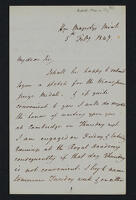
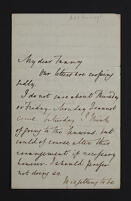
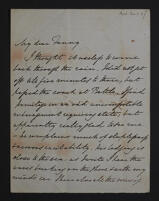
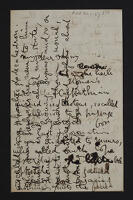
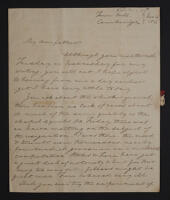
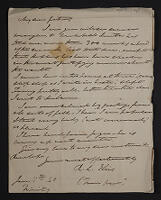
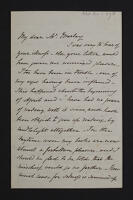
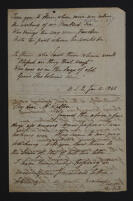
![Letters from Robert Leslie Ellis to [William] Walton](/uploads/r/trinity-college-library/1/1/9/11987adda4757c90c67cfbd14c03633a66a8b9bf39dd492c470967d12f265421/Add.ms.c.67.7-8_thumb.jpg)
![Letters from Robert Leslie Ellis to [William] Walton](/uploads/r/trinity-college-library/8/f/3/8f30ec493294eb4cc692d2891708084e56bc00f545bfddcd5a1db6ebf9c42b06/Add.ms.c.67.10-88_thumb.jpg)

![Letters from Robert Leslie Ellis to [William Whewell]](/uploads/r/trinity-college-library/f/c/7/fc7598777cae689b4e92dce42769a8471f5b536862917b31965982971f6f7ebe/Add.ms.c.67.100-108_thumb.jpg)
